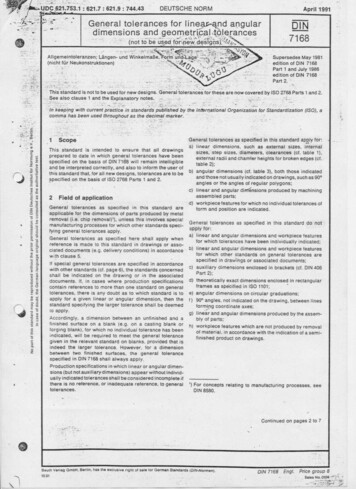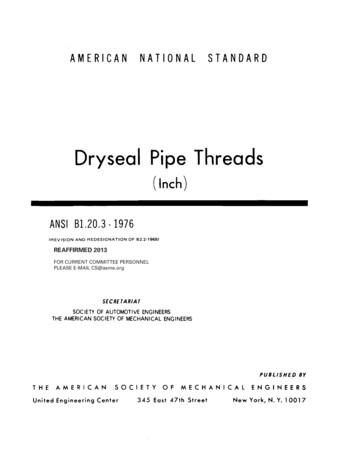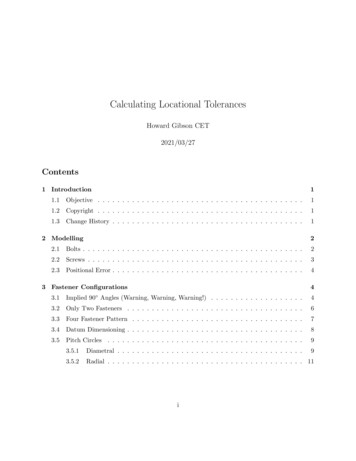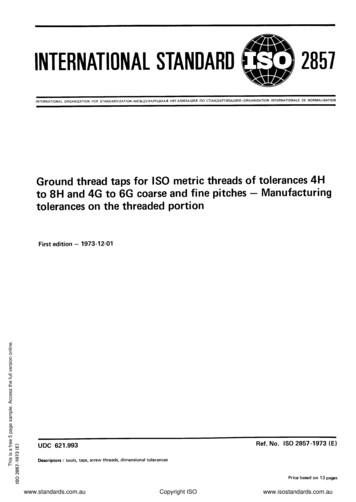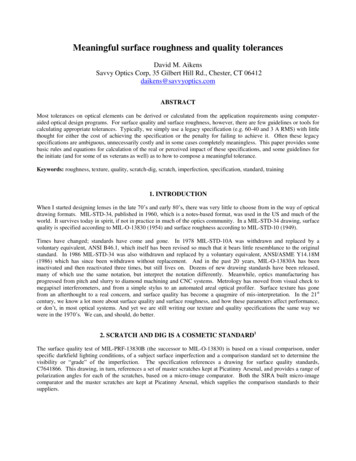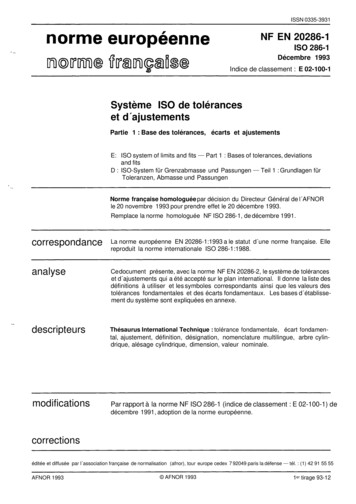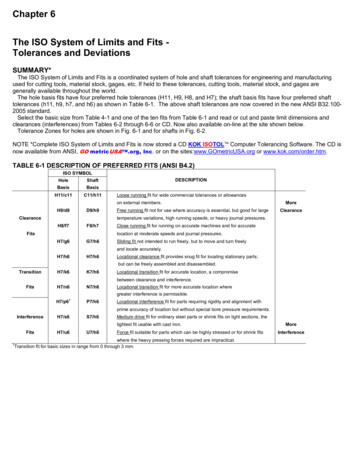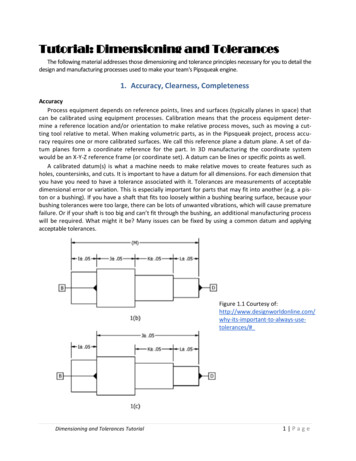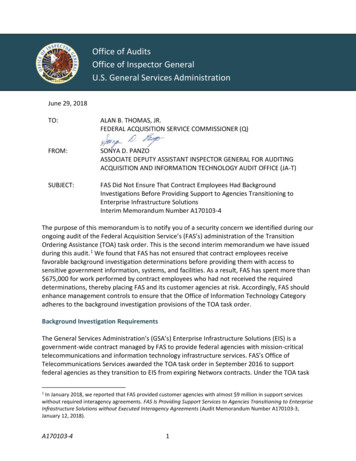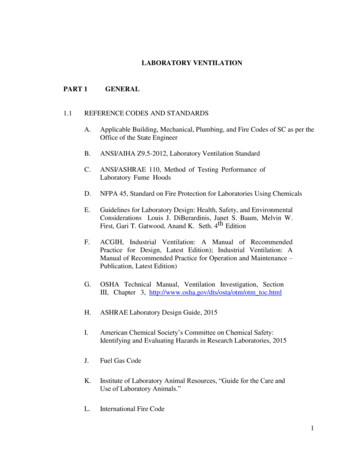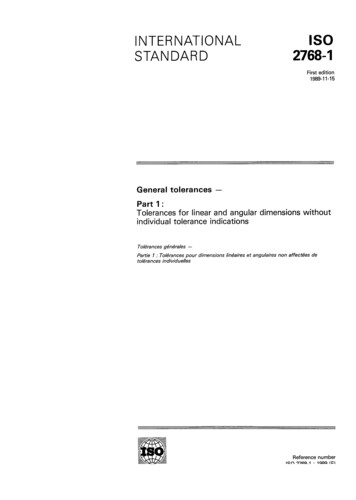
Transcription
INTERNATIONALSTANDARDISO2768-1First edition1989-11-15General tolerancesPart 1:Tolerances for linear and angular dimensions withoutindividual tolerance indicationsTolerances generales Partie 1 : Tolerances pour dimensions lineaires et angulaires non affectees detolerances individuellesReference numberICn ' 71':Q 1 1QQQ II \
ISO 2768-11989 (E)ForewordISO (the International Organization for Standardization) is a worldwide federation ofnational standards bodies (ISO member bodies). The work of preparing InternationalStandards is normally carried out through ISO technical committees. Each memberbody interested in a subject for which a technical committee has been established hasthe right to be represented on that committee. International organizations, governmental and non-governmental, in liaison with ISO, also take part in the work. ISOcollaborates closely with the International Electrotechnical Commission (IEC) on allmatters of electrotechnical standardization.Draft International Standards adopted by the technical committees are circulated tothe member bodies for approval before their acceptance as International Standards bythe ISO Council. They are approved in accordance with ISO procedures requiring atleast 75 % approval by the member bodies voting.International Standard ISO 2768-1 was prepared by Technical Committee ISO/TC 3,Limits and fits.This first edition of ISO 2768-1, together with ISO 2768-2 : 1989, cancel and replaceISO 2768 : 1973.ISO 2768 consists of the following parts, under the general title General tolerances:Part 1: Tolerances for linear and angular dimensions without individualtolerance indications- Part 2: Geometrical tolerances for features without individual tolerance indicationsAnnex A of this part of ISO 2768 is for information only. ISO 1989All rights reserved. No part of this publication may be reproduced or-utilized in any form or by anymeans, electronic or mechanical, including photocopying and microfilm, without permission inwriting from the publisher.International Organization for StandardizationCase postale 56 CH-1211 Geneve 20 SwitzerlandPrinted in Switzerlandii
ISO 2768-11989 (E)IntroductionAll features on component parts always have a size and a geometrical shape. Forthe deviation of size and for the deviations of the geometrical characteristics (form,orientation and location) the function of the part requires limitations which, whenexceeded, impair this function.The tolerancing on the drawing should be complete to ensure that the elements of sizeand geometry of all features are controlled, i.e. nothing shall be implied or left to judgement in the workshop or in the inspection department.The use of general tolerances for size and geometry simplifies the task of ensuring thatthis prerequisite is met.iii
ISO 2768-1 : 1989 (E)INTERNATIONAL STANDARDGeneral tolerances Part 1 :Tolerances for linear and angular dimensions without individualtolerance indications1ScopeThis part of ISO 2768 is intended to simplify drawing indications and it specifies general tolerances for linear and angulardimensions without individual tolerance indications in four tolerance classes.NOTE 1 - The concepts behind the general tolerancing of linear andangular dimensions are described in annex A.2GeneralWhen selecting the tolerance class, the respective customaryworkshop accuracy has to be taken into consideration. If smaller tolerances are required or larger tolerances are permissibleand more economical for any individual feature, such tolerances should be indicated adjacent to the relevant nominal dimension(s).Parallel International Standards exist or are planned, e.g. seeISO 80621l for castings.General tolerances for linear and angular dimensions applywhen drawings or associated specifications refer to this part ofISO 2768 in accordance with clauses 4 and 5. If there are general tolerances for other processes, as specified in other International Standards, reference shall be made to them on thedrawings or associated specifications. For a dimensionbetween an unfinished and a finished surface, e.g. of cast orforged parts, for which no individual tolerance is directly indicated, the larger of the two general tolerances in questionapplies, e.g. for castings, see ISO 80621l,This part of ISO 2768 only applies for the following dimensionswhich do not have an individual tolerance indication :3It applies to the dimensions of parts that are produced by metalremoval or parts that are formed from sheet metal.NOTES2 These tolerances may be suitable for use with materials other thanmetal.3a) linear dimensions (e.g. external sizes, internal sizes,step sizes, diameters, radii, distances, external radii andchamfer heights for broken edges);b) angular dimensions, including angular dimensionsusually not indicated, e.g. right angles (90 ). unless reference to ISO 2768-2 is made, or angles of uniform polygons;c) linear and angular dimensions produced by machiningassembled parts.It does not apply for the following dimensions :ISO 2768-2 : 1989, General tolerances - Part 2: Geometricaltolerances for features without individual tolerance indications.ISO 8015 : 1985, Technical drawings - Fundamental tolerancing principle.4b)4.1c) theoretically exact dimensions indicated in rectangularframes.1)The following standards contain provisions which, throughreference in this text, constitute provisions of this part ofISO 2768. At the time of publication, the editions indicatedwere valid. All standards are subject to revision, and parties toagreements based on this part of ISO 2768 are encouraged toinvestigate the possibility of applying the most recent editionsof the standards indicated below. Members of IEC and ISOmaintain registers of currently valid International Standards.a) linear and angular dimensions which are covered byreference to other standards on general tolerances;auxiliary dimensions indicated in brackets;Normative referencesGeneral tolerancesLinear dimensionsGeneral tolerances for linear dimensions are given in tables 1and 2.ISO 8062 : 1984, Castings - System of dimensional tolerances.1
ISO 2768-14.21989 (E)Angular dimensionsa)General tolerances specified in angular units control only thegeneral orientation of lines or line elements of surfaces, but nottheir form deviations.b) the tolerance class in accordance with this part ofISO 2768.EXAMPLEThe general orientation of the line derived from the actual surface is the orientation of the contacting line of ideal geometricalform. The maximum distance between the contacting line andthe actual line shall be the least possible value (see ISO 8015).ISO 2768-mThe permissible deviations of angular dimensions are given intable 3.56RejectionUnless otherwise stated, workpieces exceeding the generaltolerance shall not lead to automatic rejection provided that theability of the workpiece to function is not impaired (seeclause A.4).Indications on drawingsIf general tolerances in accordance with this part of ISO 2768shall apply, the following information shall be indicated in ornear the title block :Table 1 -"ISO 2768";Permissible deviations for linear dimensions except for broken edges(external radii and chamfer heights, see table 2)Values in millimetresTolerance class0,51)DesignationDescriptionup to31)Permissible deviations for basic size rangeoveroveroverover301206400up toup toup toup to120304001 000over3up to6overover1 0002000up toup to20004000 0,1 0,15 0,2 0,3 0,5- 0,1 0,2 0,3 0,5 0,8 1,2 2 0,2 0,3 0,5 0,8 1,2 2 3 4- 0,5 1 1,5 2,5 4 6 8ffine 0,05 0,05mmedium 0,1ccoarsevvery coarseFor nominal sizes below 0,5 mm, the deviations shall be indicated adjacent to the relevant nominal size(s).Table 2 -Permissible deviations for broken edges (external radii and chamfer heights)Values in millimetresTolerance ery coarse 0,5 1 0,4 1 2Permissible deviations of angular dimensionsTolerance class2 0,2For nominal sizes below 0,5 mm, the deviations shall be indicated adjacent to the relevant nominal size(s).Table 3 -DesignationPermissible deviations for basic size rangeover 3 up to 6over 60,511 up to 3Descriptionffinemmediumccoarsevvery coarseup to 10Permissible deviations for ranges of lengths, in millimetres,of the shorter side of the angle concernedover 10 up to 50 over 50 up to 120 over 120 up to 400over 400 10 0 30' 0 20' 0010' 0 5' 1 30' 10 0 30' 0 15' 0 10' 30 20 10 0 30' 0 20'
ISO 2768-11989 (E)Annex A(informative)Concepts behind general tolerancing of linear and angular dimensionsA.1General tolerances should be indicated on the drawingby reference to this part of ISO 2768 in accordance withclause 5.c) the drawing readily indicates which feature can be produced by normal process capability, which also assistsquality engineering by reducing inspection levels;The values of general tolerances correspond to toleranceclasses of customary workshop accuracy, the appropriatetolerance class being selected and indicated on the drawing according to the requirement for the components.d) those dimensions remaining, which have individually indicated tolerances, will, for the most part, be those controlling features for which the function requires relatively smalltolerances and which therefore may require special effort inthe production - this will be helpful for production planning and will assist quality control services in their analysisof inspection requirements;A.2Above certain tolerance values, there is usually no gainin manufacturing economy by enlarging the tolerance. Forexample, a feature having a 35 mm diameter could be manufactured to a high level of conformance in a workshop with"customary medium accuracy". Specifying a tolerance of 1 mm would be of no benefit in this particular workshop, asthe general tolerance values of 0,3 mm would be quiteadequate.However, if, for functional reasons, a feature requires a smallertolerance value than the "general tolerances", then that featureshould have the smaller tolerance indicated individually adjacent to the dimension defining its size or angle. This type oftolerance falls outside the scope of general tolerances.In cases where the function of a feature allows a toleranceequal to or larger than the general tolerance values, theseshould not be indicated adjacent to the dimension but shouldbe stated on the drawing as described in clause 5. This type oftolerance allows full use of the concept of general tolerancing.There will be "exceptions to the rule" where the function of thefeature allows a larger tolerance than the general tolerances,and the larger tolerance will provide manufacturing economy.In these special cases, the larger tolerance should be indicatedindividually adjacent to the dimension for the particular feature,e.g. the depth of blind holes drilled at assembly.A.3Using general tolerances leads to the following advan-tages:a) drawings are easier to read and thus communication ismade more effective to the user of the drawing;b) the design draughtsman saves time by avoiding detailed tolerance calculations as it is sufficient only to knowthat the function allows a tolerance greater than or equal tothe general tolerance;e) purchase and sub-contract supply engineers cannegotiate orders more readily since the "customaryworkshop accuracy" is known before the contract is placed;this also avoids arguments on delivery between the buyerand the supplier, since in this respect the drawing is complete.These advantages are fully obtained only when there issufficient reliability that the general tolerances will not beexceeded, i.e. when the customary workshop accuracy of theparticular workshop is equal to or finer than the generaltolerances indicated in the drawing.The workshop should, thereforefind out by measurements what its customaryworkshop accuracy is;accept only those drawings having general tolerancesequal to or greater than its customary workshop accuracy;check by sampling that its customary workshop accuracy does not deteriorate.Relying on undefined "good workmanship" with all its uncertainties and misunderstandings is no longer necessary with theconcept of general geometrical tolerances. The generalgeometrical tolerances define the required accuracy of "goodworkmanship".A.4 The tolerance the function allows is often greater thanthe general tolerance. The function of the part is, therefore, notalways impaired when the general tolerance is (occasionally)exceeded at any feature of the workpiece. Exceeding thegeneral tolerance should lead to a rejection of the workpieceonly if the function is impaired.3
ISO 2768-11989 (E)UDC 621.753.1 : 744.4Descriptors : fundamental tolerances, dimensional tolerances, angular tolerances.Price based on 3 pages
ISO 2768-1 1989 (E) 4.2 Angular dimensions a) "ISO 2768"; General tolerances specified in angular units control only the general orientation of lines or line elements of surfaces, but not their form deviations. b) the tolerance class in accordance with this part of ISO 2768.
